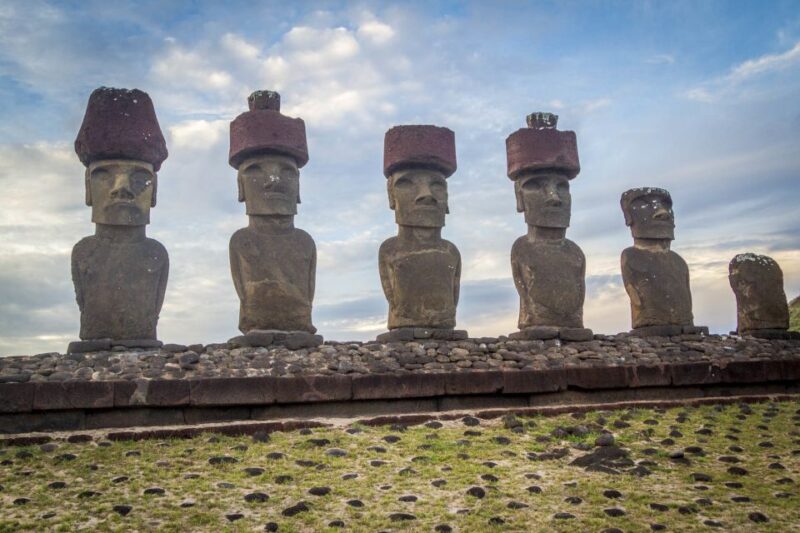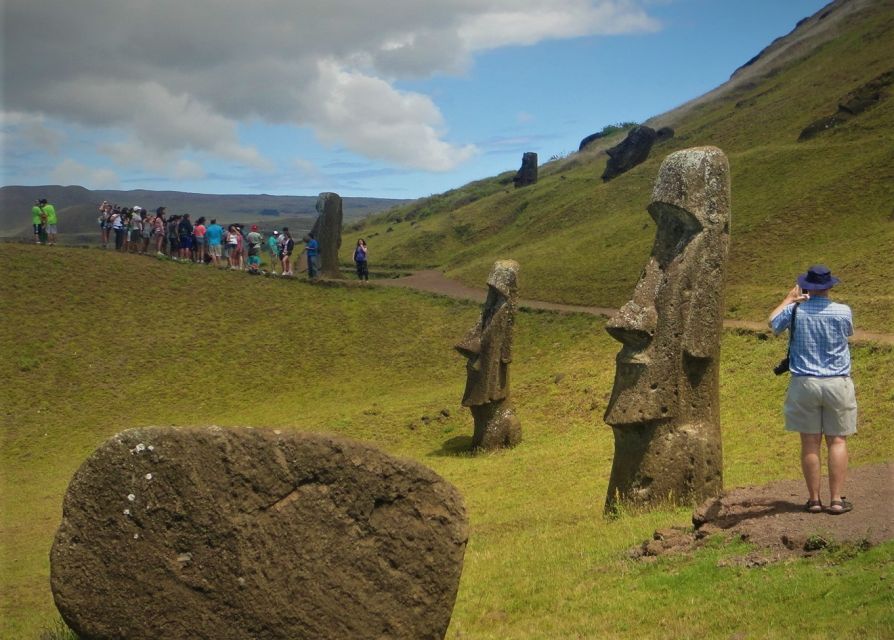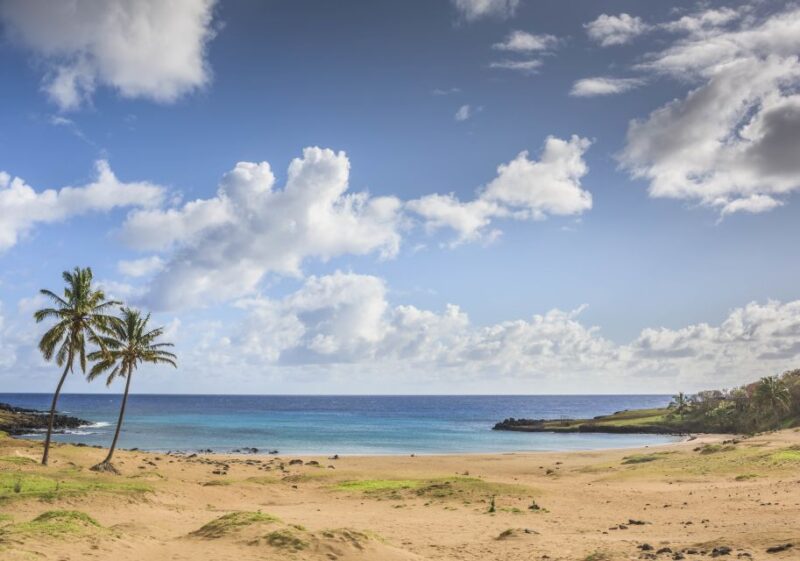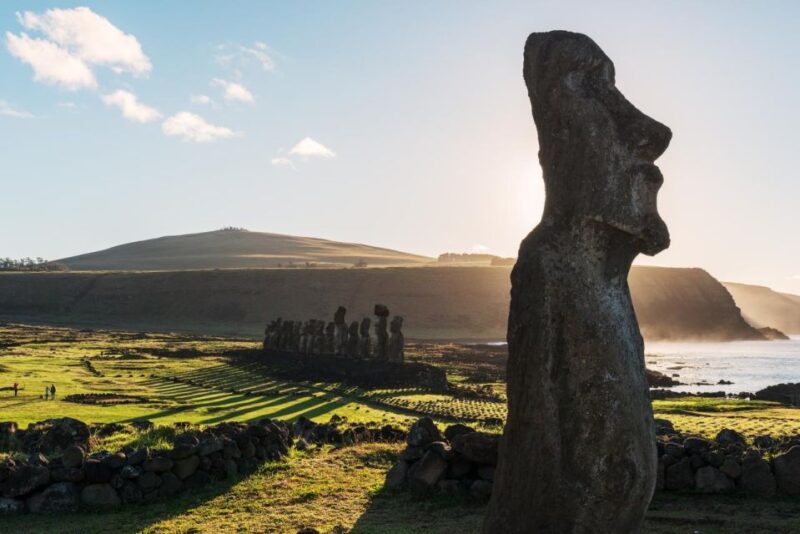Situated in the remote reaches of the Pacific Ocean, Easter Island beckons adventurers and history enthusiasts alike with its enigmatic moai statues and rich cultural heritage. The "Easter Island: The Moai Trail Private Archeological Tour" promises to unveil the island’s secrets, guiding participants through a captivating 7-hour exploration of its most significant sites. From the towering stone figures at Ahu Tongariki to the quarry where they were carved, this immersive experience delves into the intriguing history and construction techniques that have long puzzled scholars. However, the tour’s true allure lies in the opportunity to connect with the island’s indigenous Rapa Nui people and witness the breathtaking landscapes that have captivated visitors for generations.
Key Points
- Comprehensive 7-hour private guided tour exploring the key archeological sites and moai on Easter Island, including Ahu Tongariki, Rano Raraku Quarry, and Anakena Beach.
- Insightful discussions on Rapa Nui history, tribal conflicts, and moai construction techniques led by knowledgeable guides for a personalized and enriching experience.
- Opportunity to view moai in various stages of carving at the Rano Raraku Quarry and learn about the monumental achievements of the Rapa Nui culture.
- Emphasis on respectful treatment of the island’s culture and environment, providing an authentic and culturally-sensitive experience.
- Tour not suitable for individuals with mobility impairments, but accommodates cruise ship guests with a focus on accessibility within the tour’s limitations.
Tour Overview

What does the Easter Island Moai Trail Tour entail? This private guided tour immerses visitors in the archaeological wonders of Easter Island for 7 hours.
For $200 per person, plus $80 in entrance fees, guests can explore the island’s most significant sites, including Ahu Tongariki, Rano Raraku Quarry, and Anakena Beach.
The tour covers Rapa Nui history, tribal conflicts, and the construction of the iconic moai statues. Participants will learn about hare paenga homes and view petroglyphs at Ahu Nau Nau.
The private format allows for a personalized experience with a knowledgeable guide, who provides insightful discussions on the island’s culture and current issues.
Guests should wear comfortable shoes and bring warm clothing.
Want to keep it personal? More private experiences we love in Hanga Roa
Itinerary Highlights

The Moai Trail Tour takes visitors on a captivating journey through Easter Island‘s most significant archaeological sites.
Highlights include:
-
Witnessing the imposing presence of Ahu Tongariki, the largest ahu (platform) with 15 moai (statues) standing tall.
-
Delving into the ancient quarry of Rano Raraku, where visitors can observe moai in various stages of carving.
-
Exploring the Ahu Te Pito Kura site, home to the tallest individual moai statue on the island.
Throughout the tour, guests gain invaluable insights into Rapa Nui history, tribal conflicts, and the intricate techniques used in constructing these enigmatic stone figures.
Experience and Learning

Through a private tour format, visitors can enjoy a personalized experience guided by knowledgeable professionals.
The tour provides insightful discussions on Rapa Nui culture, history, and current issues, offering a deeper understanding of this enigmatic island.
Participants have the opportunity to view moai in various stages of carving at the Rano Raraku quarry, giving them a unique glimpse into the intricate process of constructing these iconic statues.
The guide’s expertise and the intimate group setting enable meaningful engagement, fostering an appreciation for the respectful treatment of Rapa Nui’s culture and environment throughout the tour.
Participant Information

Although the tour isn’t suitable for people with mobility impairments or wheelchair users, it can accommodate guests from cruise ships.
To ensure a comfortable and enriching experience, participants should bring:
- Comfortable, closed-toe shoes for walking on uneven terrain
- Layers of warm clothing to prepare for varying weather conditions
- Sun protection, such as hats, sunscreen, and sunglasses
The tour’s attention to cultural sensitivity and environmental preservation allows visitors to engage with the island’s history and indigenous traditions in a respectful manner.
More Great Thing To Do NearbyCustomer Reviews

According to reviews, the Easter Island Moai Trail Tour has consistently received high ratings, with an overall score of 4.9 out of 5 based on 8 customer evaluations. Tourists have praised the tour’s knowledgeable and engaging guides, who provide insightful discussions on Rapa Nui culture, history, and current issues. Reviewers express appreciation for the tour’s respectful treatment of the island’s environment and cultural heritage, as well as the unique opportunity to view the moai in various stages of carving at the Rano Raraku quarry.
| Positive Feedback | Negative Feedback |
|---|---|
| Knowledgeable guides | Mobility limitations |
| Well-organized tours | Cruise ship guests |
| Cultural insights | None reported |
| Respectful treatment | None reported |
| Unique experiences | None reported |
- 2-Day Private Tour Easter Island Highlights Complete Discovery
- Easter Island Full-Day Tour: Ahu Tongariki, Rano Raraku and Anakena Beach
- Private Full-Day Easter Island Highlights South and East
- Private Easter Island Full-Day Tour
- Private Full-Day Easter Island Highlights North and West
- Small Group Wines and Flavours Guided Walking Tour
Exploring Ahu Akahanga
The tour begins at the archaeological site of Ahu Akahanga, which is renowned for its fascinating history and well-preserved ruins.
This ancient ceremonial site holds deep significance, as it’s believed to be the burial place of the island’s first king, Hotu Matu’a.
Visitors can:
- Explore the remaining stone platforms and explore the hare paenga (boat-shaped stone houses) that once dotted the landscape.
- Learn about the site’s role in the power struggles and tribal conflicts that shaped Rapa Nui’s past.
- Gain insights into the construction techniques and cultural traditions associated with the moai statues found here.
The guide’s expert commentary brings this captivating location to life, offering a window into the island’s rich heritage.
Discovering Rano Raraku
From the historic Ahu Akahanga, the tour ventures to the awe-inspiring Rano Raraku, the renowned quarry where the famous moai of Easter Island were carved. This distinctive volcanic crater was the source of the immense stone figures, and visitors can observe the moai in various stages of completion, some still attached to the bedrock. The tour provides a deeper understanding of the remarkable feat of engineering and artistry required to create these iconic symbols of Rapa Nui culture.
| Feature | Description |
|---|---|
| Rano Raraku | The quarry where moai were carved |
| Unfinished Moai | Visible at various stages of completion |
| Volcanic Crater | The dramatic natural setting of the quarry |
| Scale of Moai | Appreciation for the massive size and weight |
| Cultural Significance | Insight into the monumental achievement |
Visiting Anakena Beach
The tour culminates with a visit to the sun-drenched Anakena Beach, Easter Island’s picturesque white-sand oasis. This stunning natural wonder sits nestled between towering palm trees and dramatic volcanic cliffs.
Visitors can:
- Explore the archaeological site of Ahu Nau Nau, featuring five well-preserved moai statues
- Swim in the crystal-clear waters and soak up the island’s tranquil atmosphere
- Enjoy a picnic lunch while taking in the breathtaking scenery
This serene destination provides a peaceful respite after a day of exploring Easter Island’s iconic monumental heritage, leaving guests with a lasting impression of the island’s natural beauty and cultural significance.
Frequently Asked Questions
Can I Take Photographs of the Moai Statues?
Visitors can take photographs of the moai statues during the tour. However, they should be respectful and follow any guidelines provided by the tour guide to preserve the archaeological sites and Rapa Nui culture.
How Rugged Is the Terrain During the Tour?
The terrain during the tour can be quite rugged, with some uneven paths and hilly areas. Visitors should wear comfortable, sturdy shoes and be prepared for moderate walking and light hiking over varied terrain.
Is There an Option to Extend the Tour Duration?
Yes, the tour duration can be extended. Travelers can request an extended tour to explore additional archaeological sites or spend more time at certain locations, though additional fees may apply. The tour operator can provide details on customizing the itinerary.
Are There Any Age Restrictions for the Tour Participants?
The tour has no specific age restrictions. It’s suitable for participants of all ages, though the lengthy duration and challenging terrain may not be suitable for very young children or elderly individuals with limited mobility. The tour operator can provide guidance on age-appropriate participation.
Can I Purchase Souvenirs at the Archaeological Sites?
Visitors can purchase souvenirs at various archaeological sites on Easter Island, though it’s important to be mindful of cultural sensitivities and only purchase from authorized vendors. Some sites may have designated areas for purchasing local crafts and goods.
The Sum Up
The "Easter Island: The Moai Trail Private Archeological Tour" offers a captivating exploration of Rapa Nui’s cultural legacy. Guests explore the island’s rich history, uncovering the mysteries behind the iconic moai statues. Through guided visits to significant sites, travelers gain a deeper understanding of the Rapa Nui people’s resilience and environmental stewardship. Culminating at the breathtaking Anakena Beach, this immersive experience provides a unique opportunity to connect with the island’s heritage and natural wonders.
You can check if your dates are available here:More Private Tours in Hanga Roa
More Tours in Hanga Roa
More Tour Reviews in Hanga Roa
Not for you? Here's more things to do in Hanga Roa we have recnetly reviewed
- 2 Best Guided Tours In Hanga Roa
- 6 Best 2 Day Tours In Hanga Roa
- 6 Best Full-Day Tours In Hanga Roa
- 2 Best Private Car With Driver Services In Hanga Roa
- 8 Best Cruises And Boat Tours In Hanga Roa
- The Birdman Journey in Easter Island
- Rapa Nui Dinner Show on Easter Island
- Dinner, Show and Traditional Curanto Te Raai Cultural Experience
- Volcanic Wonders and the Kingdom of the Birdman: Half Day
- Private Tour: Easter Island Caves
- 4-Days Trip to Discover Easter Island
- Anakena and Rapa Nui Culture in Easter Island
